This dream can never happen
Curatorship: Carollina Lauriano, Guilherme Teixeira, Ode e Paulo Kassab Jr.
Through paintings, sculptures, installations, works on various supports, the artist Gabriella Garcia reflects on relationships that show the play of opposing pairs: the solid and the ethereal, the volume and the two-dimensional plane, the condensed and the volatile, the past and the present. An unprecedented synthesis of this research will be presented in its first solo show at Galeria Lume.
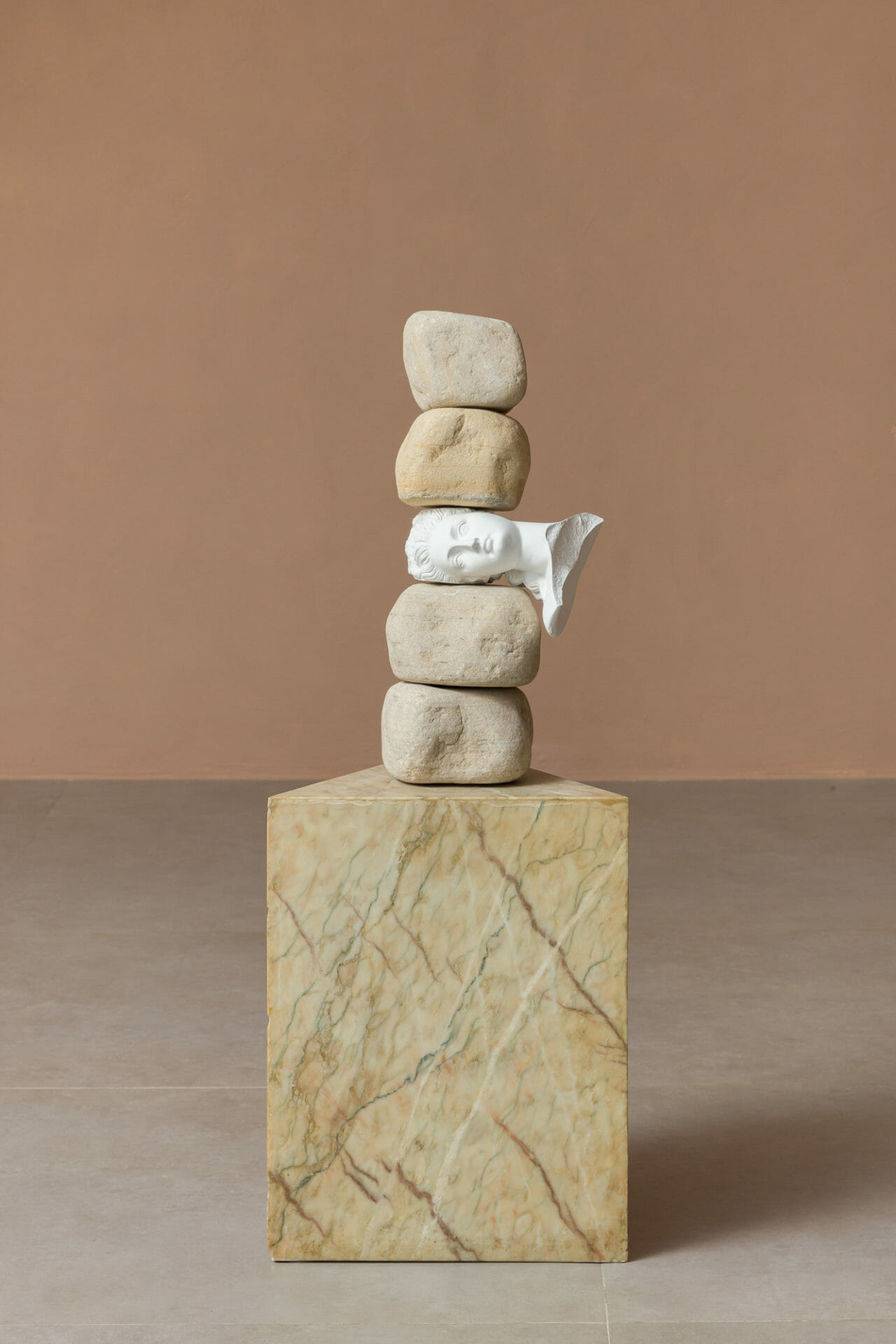
Nós não somos assim tão fortes
, 2021In the first space of the exhibition, the representation of drapery – movement of the fabrics and their folds – in the gaps between the paintings and sculptures create abstractions and new perspectives. In the second, located in Lume’s central room, everything connects and each work exists through the other, in a room whose walls are painted with mineral pigment. The relationship with the representation and its surroundings remains, and the artist materializes the painting and paints the material through various supports such as minerals, reproductions of classical images in plaster, canvases, silks and marble.
The artist brings to the public 29 works, paintings, installations and sculptures, loaded with symbols from the history of classical art, and in which she shares her questions and reflections on the hegemonic thinking that hovered in previous centuries. At the beginning of his career, his artistic process brought the use of collage as a driving force and today it carries its influences, as well as the scenic arts. Not by chance, the exhibition is organized in two acts and, open to multiple readings, has different and complementary perspectives in critical texts signed by four curators: Carollina Lauriano, Guilherme Teixeira, Ode and Paulo Kassab Jr.
“Through the plaster and marble link, studies on the balance of stones and objects and painting, profane materials and others with a decent biorepresentative; as well as mimicry and the process of making motion static, Garcia aims to demonstrate how the denial use of taxonomic models such as archetypes, catalogs, lists and indices, simultaneously with liquid properties such as astronomy, astrology, dreams and memory, can be realized in a way rhythmic and yet ironic”, reflects the independent writer and curator Ode in her text.
Gabriella Garcia elaborates a set of paintings and sculptures that deal, at first, with the idea of gestures and the making of the art object. For Carollina Lauriano, researcher and independent curator, the artist uses what is most academic and classic in art – whether in materiality or support – to justify an official story that has already been given.
“When we observe the theatricality employed in his works, we begin to realize that every gesture there may be being staged, and that the layers can hide nuances that the eyes cannot see. As in the Renaissance ideal, the artist creates objects that keep ‘regrets’ in them”, says Lauriano.

Mitos, farsas e alegorias
, 2021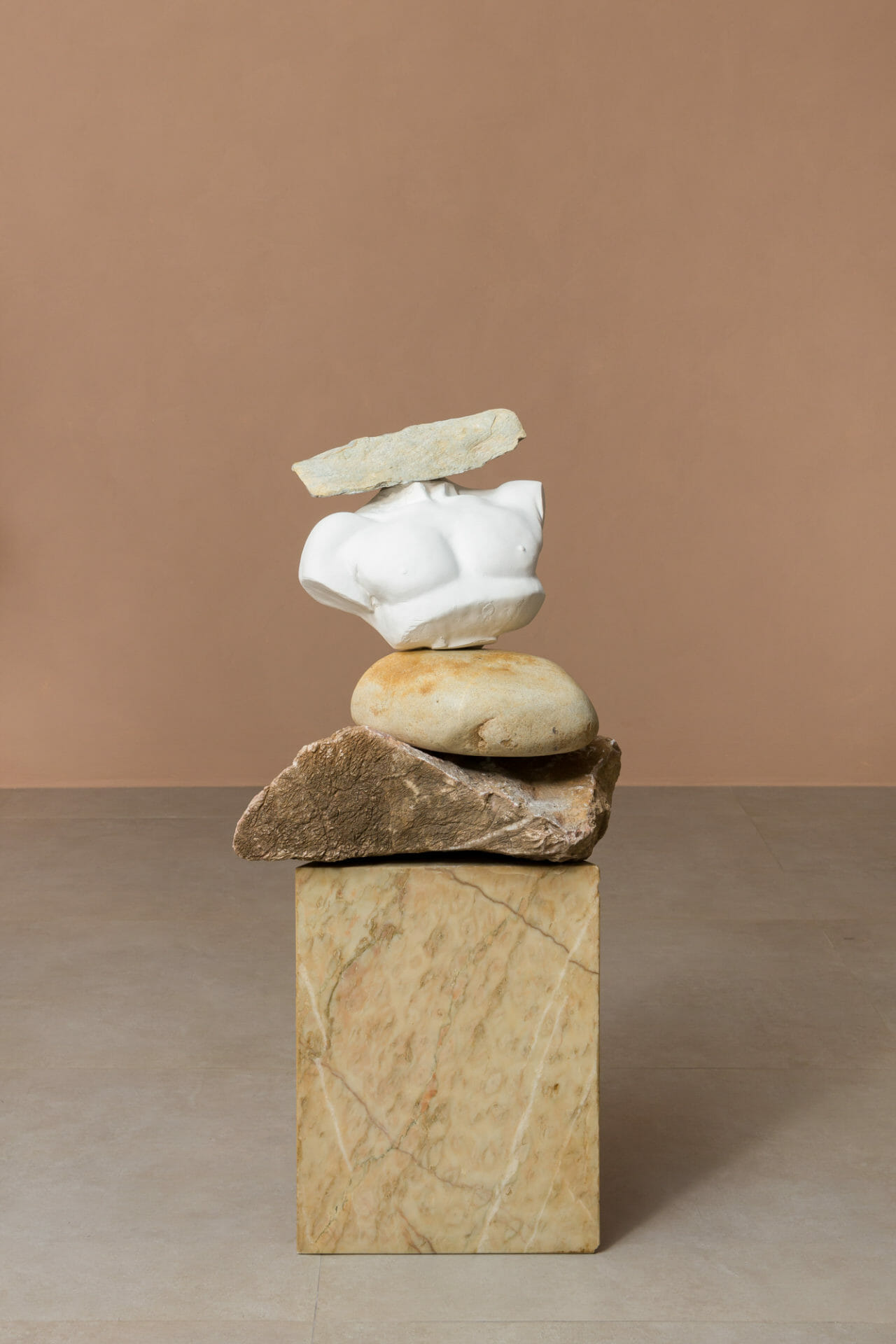
Exibiu-se sua face verdadeira
, 2021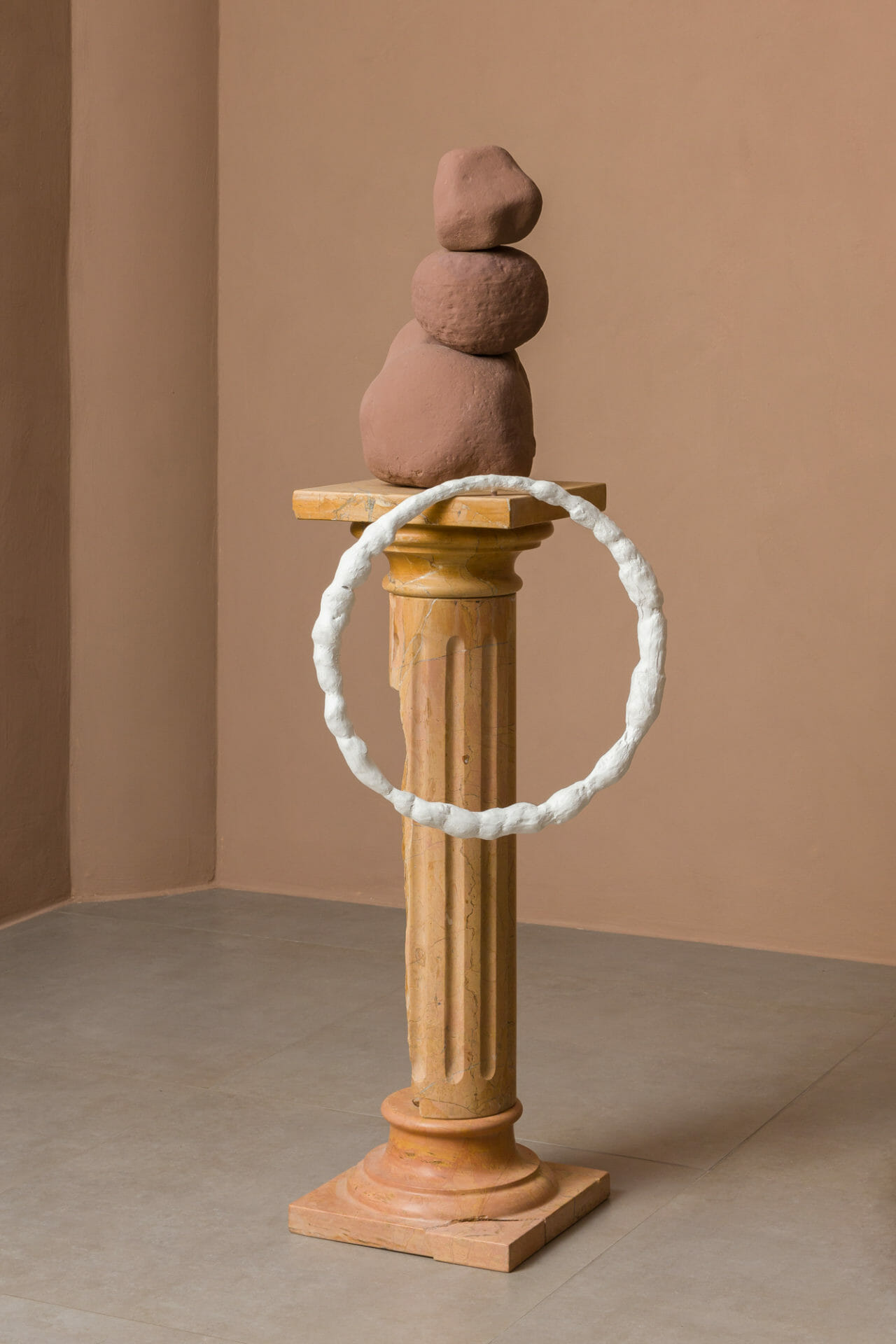
Mitos, farsas e alegorias
, 2021Idea complemented in an excerpt of the text signed by curator Guilherme Teixeira:
“There is a place here where the image allows itself to fail, and it is because of its insufficiency in relation to the species’ will that something leaks out”.
From her work, Gabriella Garcia proclaims that there is no single narrative, but that the history of art must be constantly re-signified.
“Open to multiple reinterpretations, the exhibition allows us to release the critical spirit in the light of imagination and awaken to a reading of a multiform world”, concludes Paulo Kassab Jr.

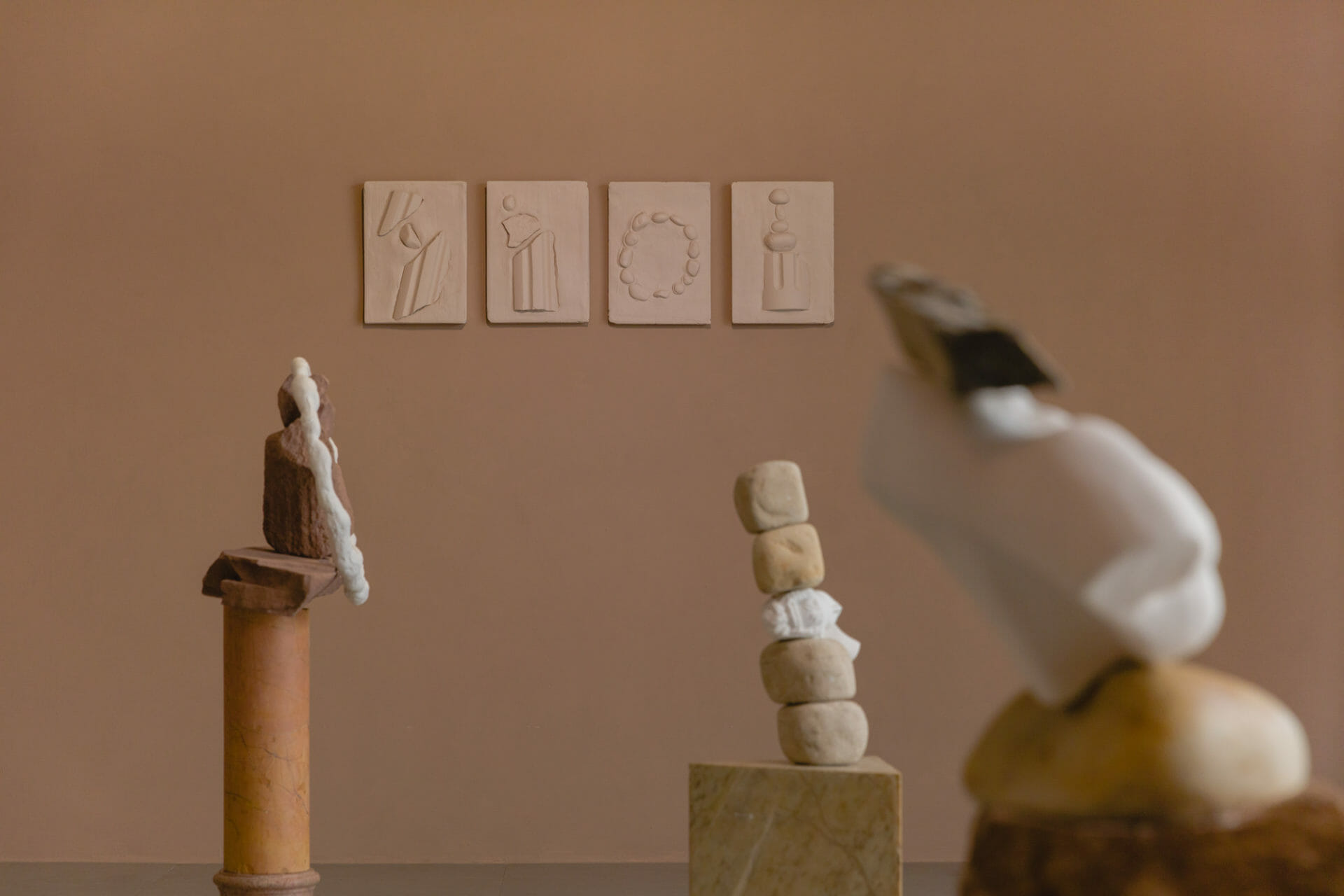
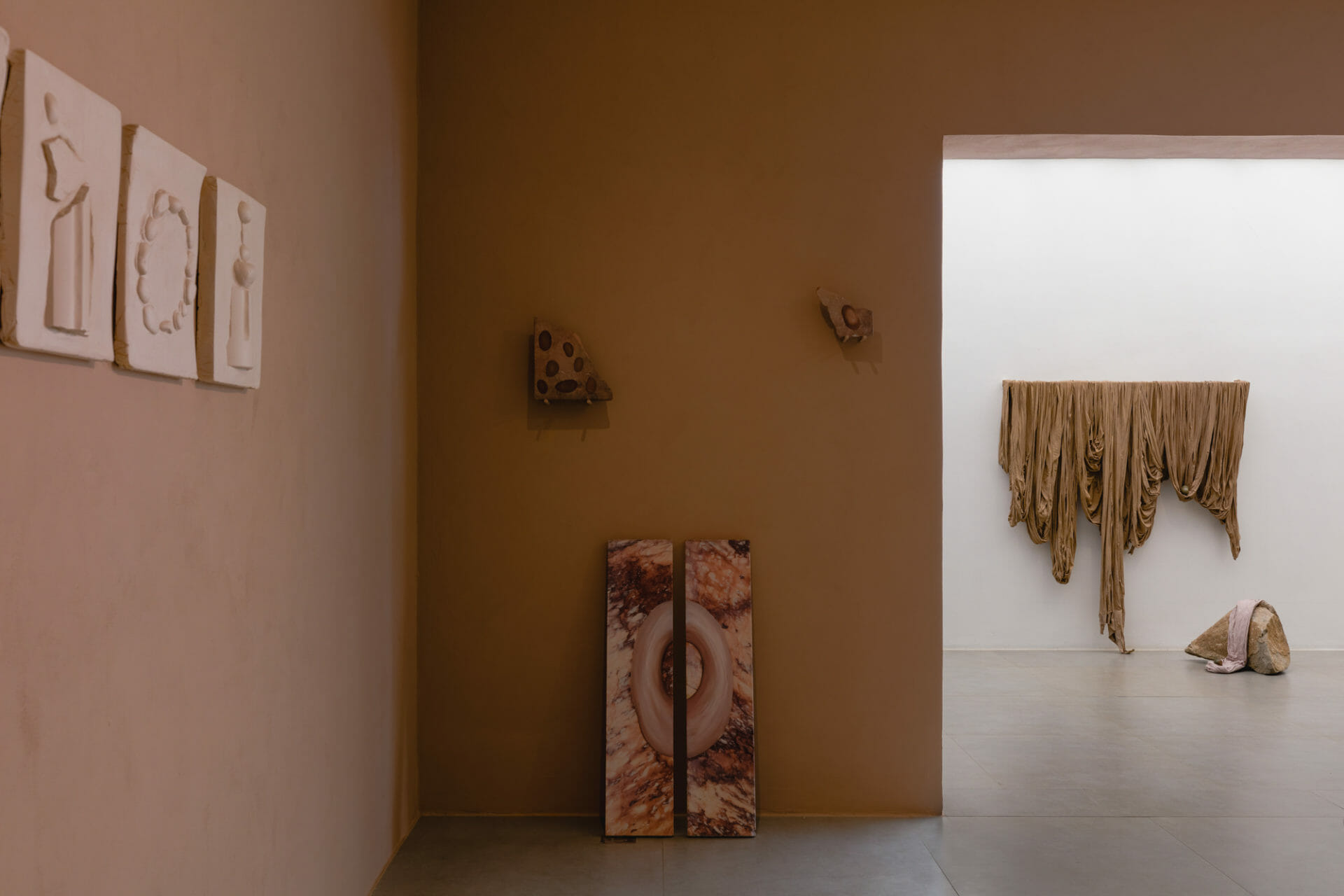
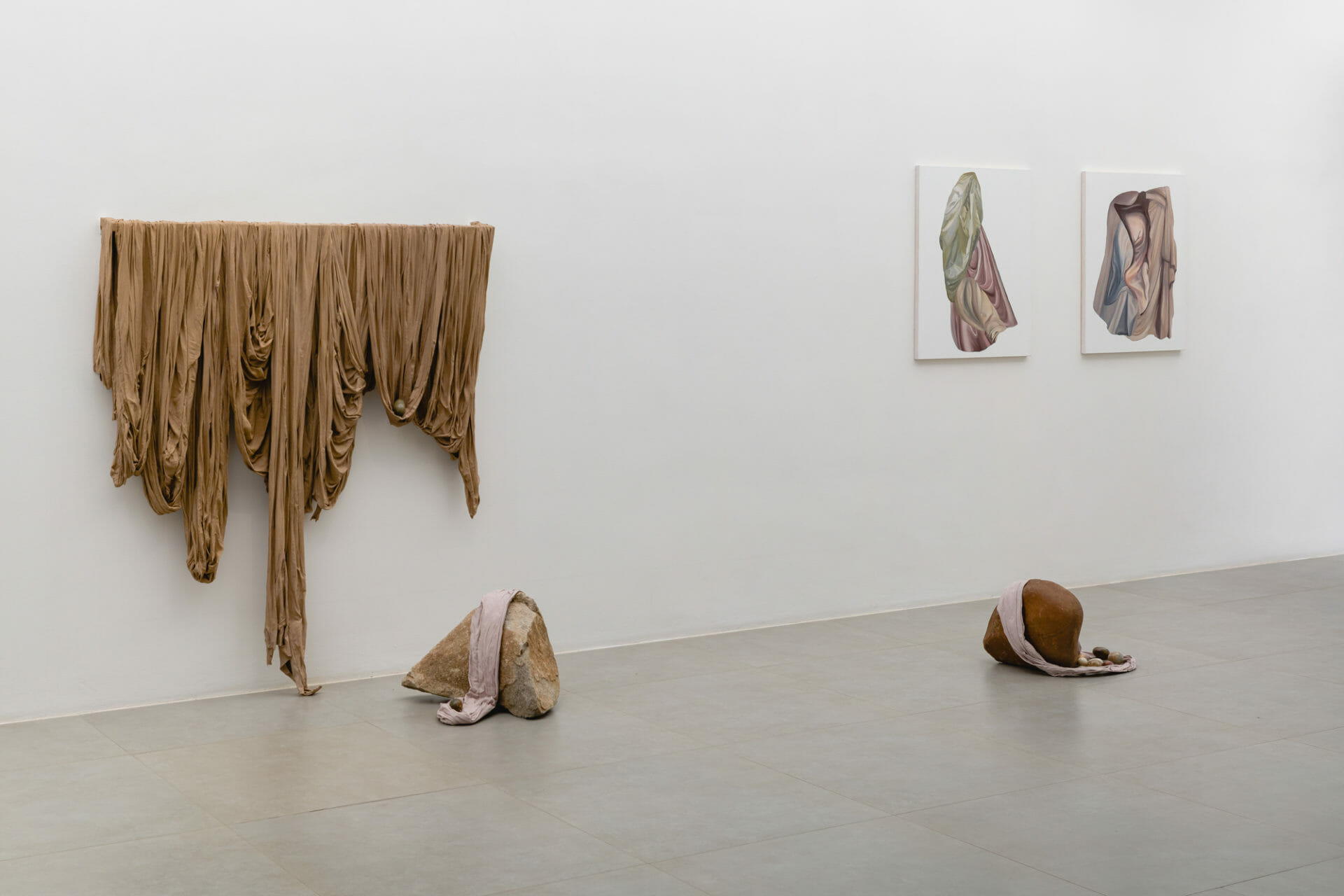
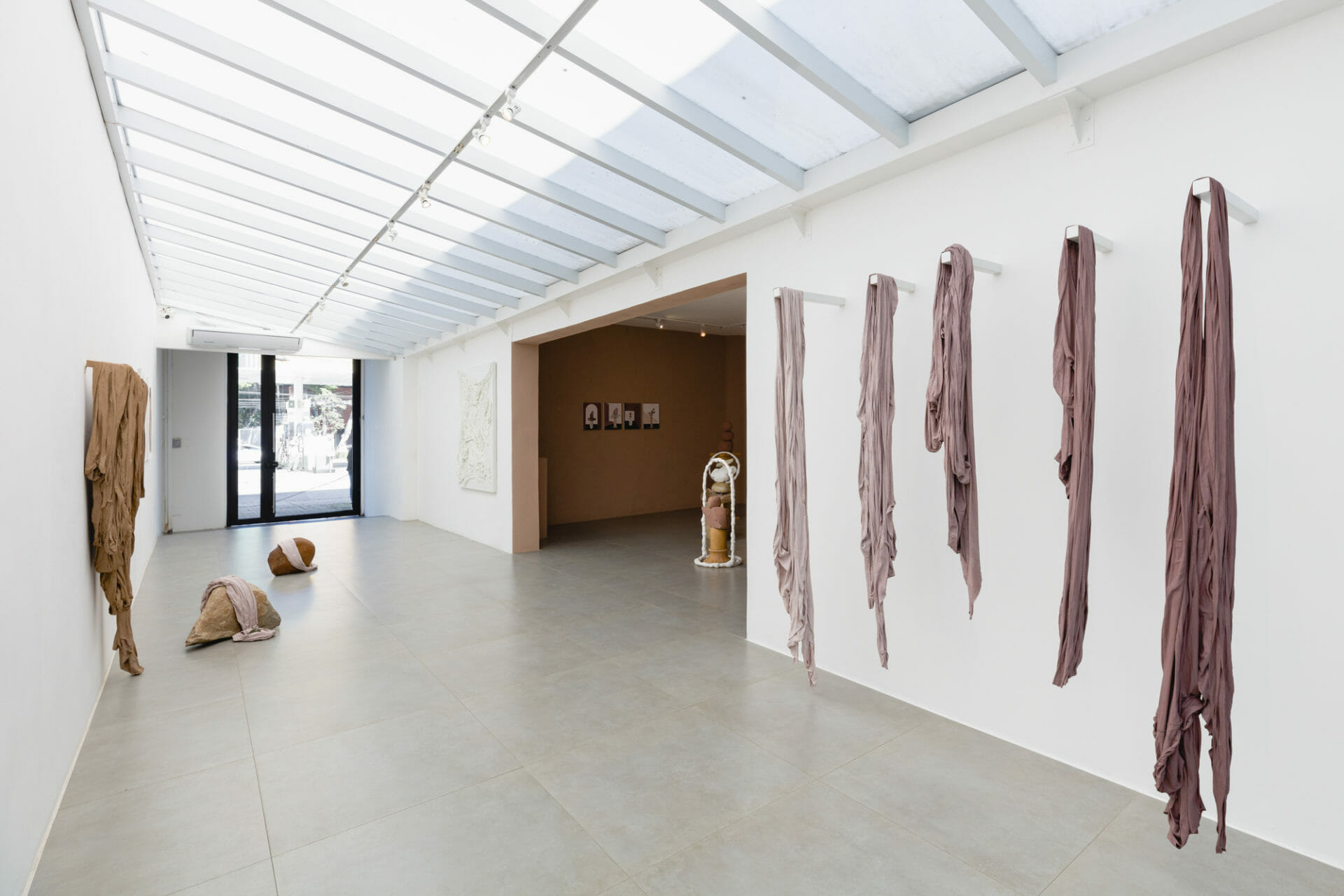
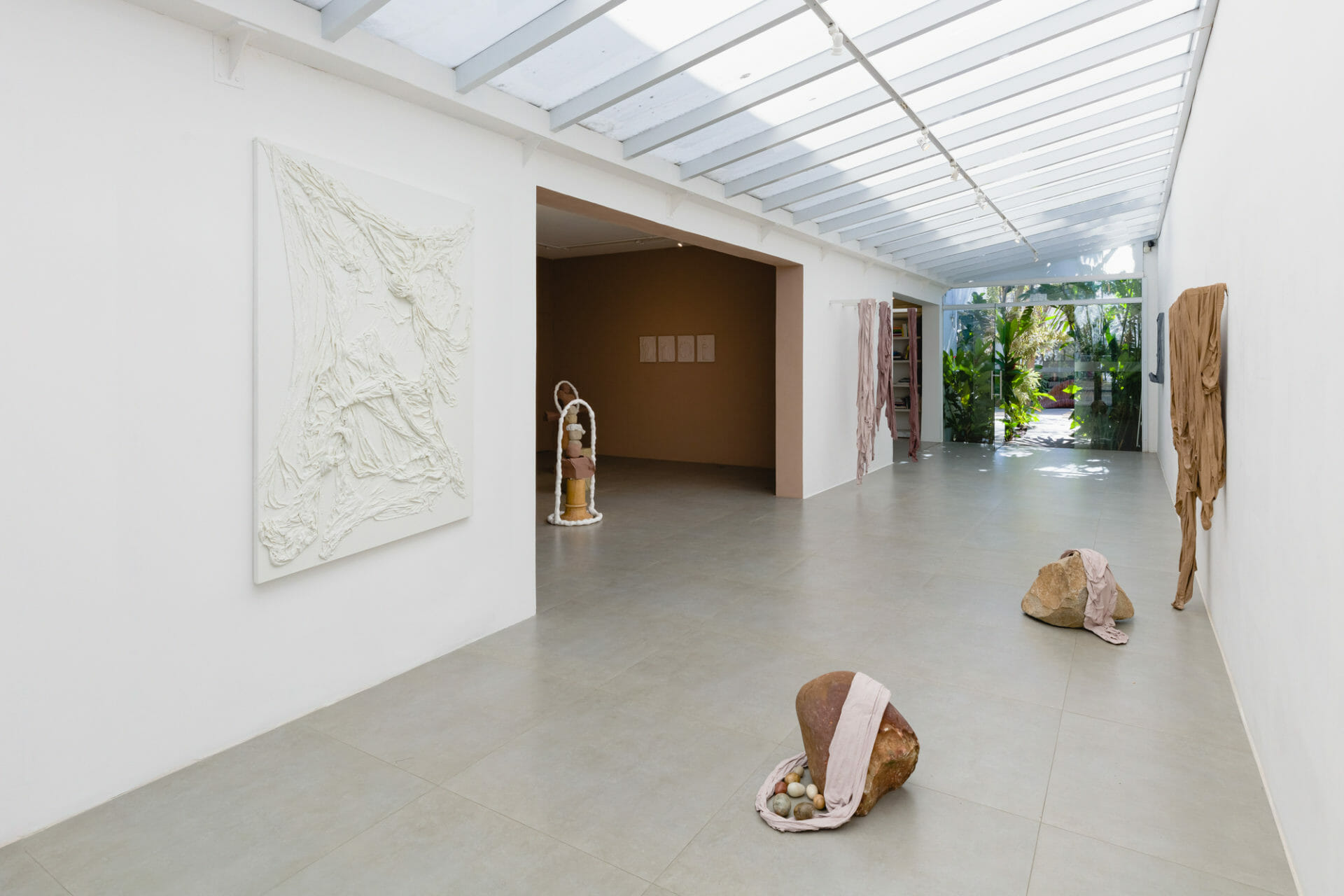


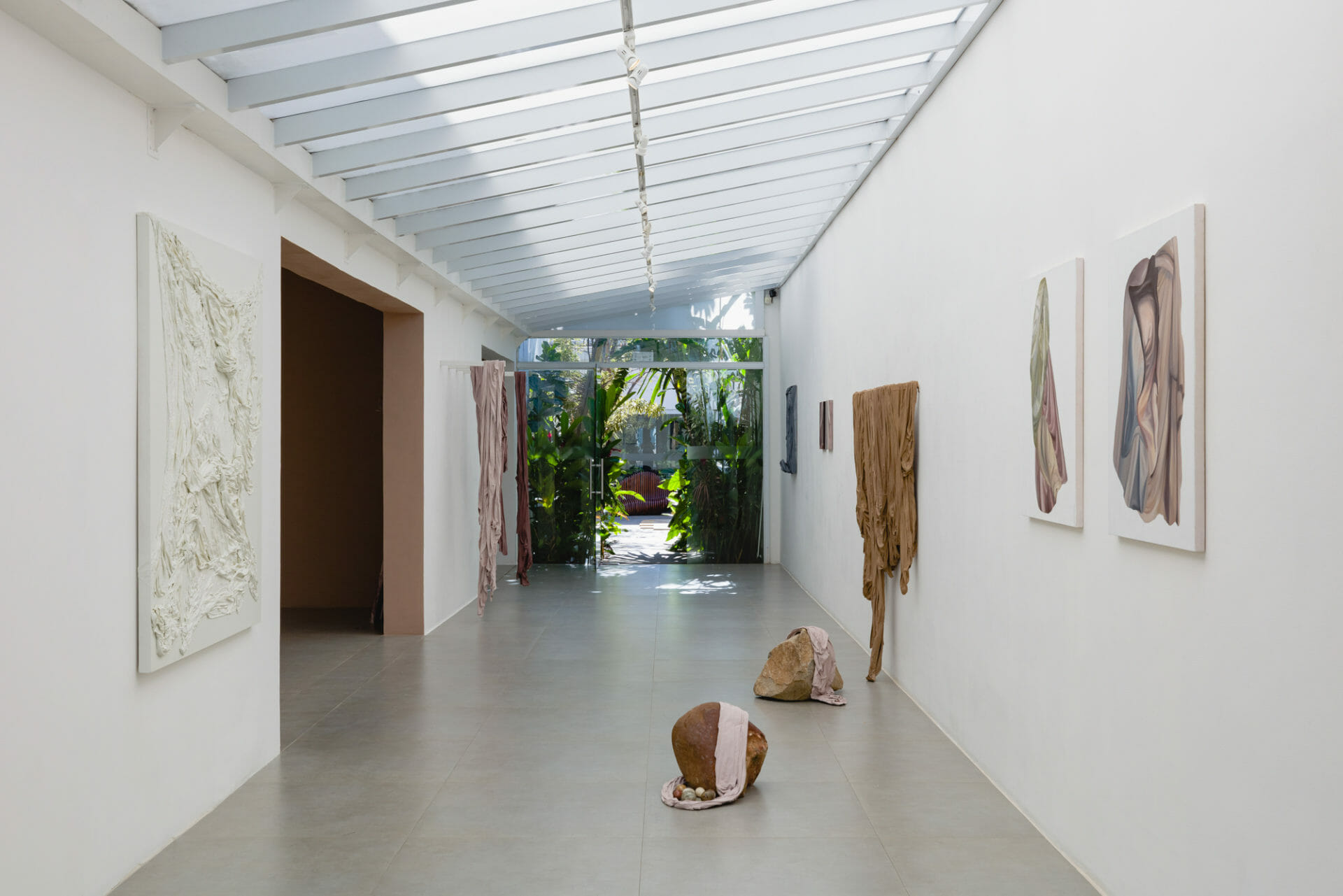
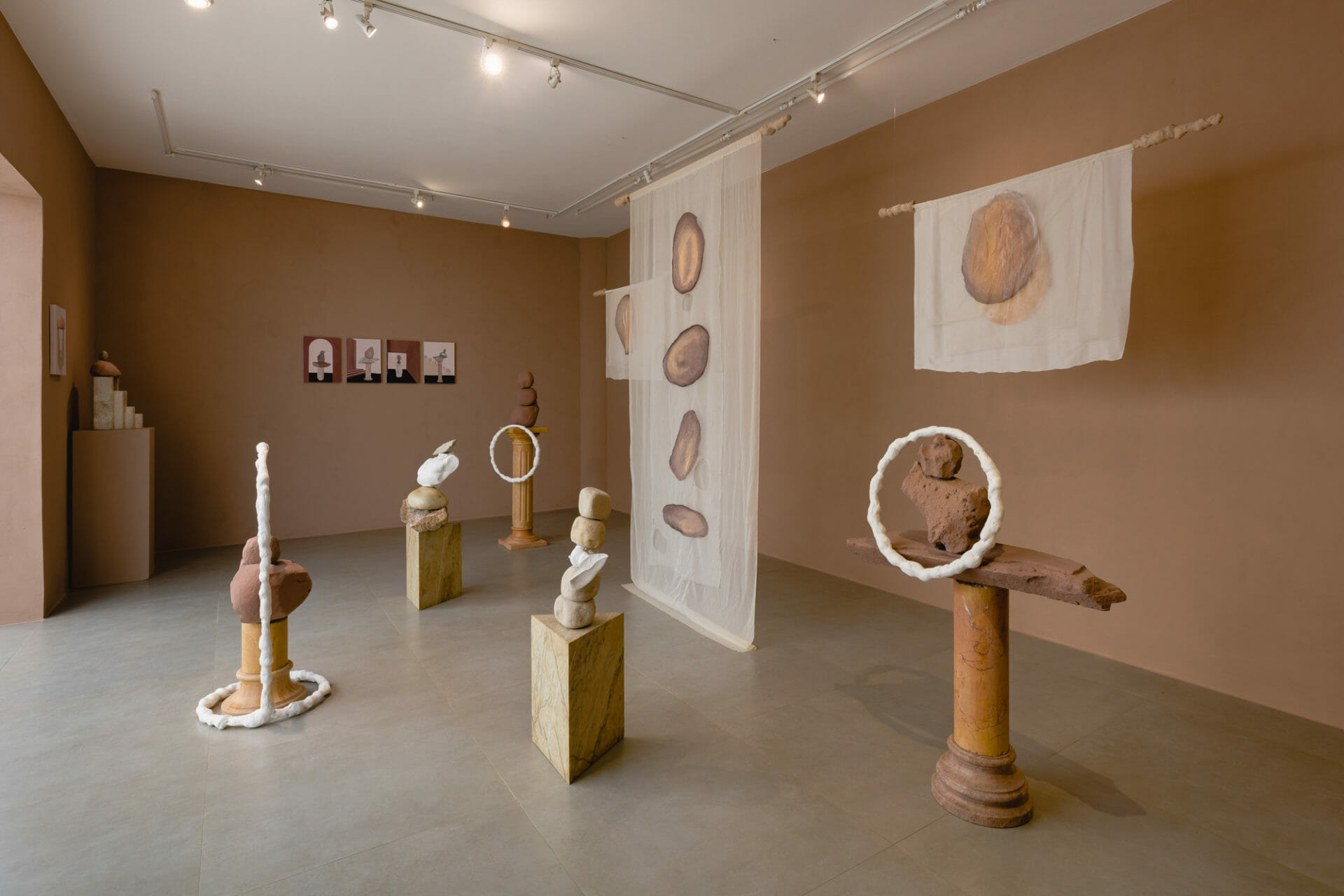
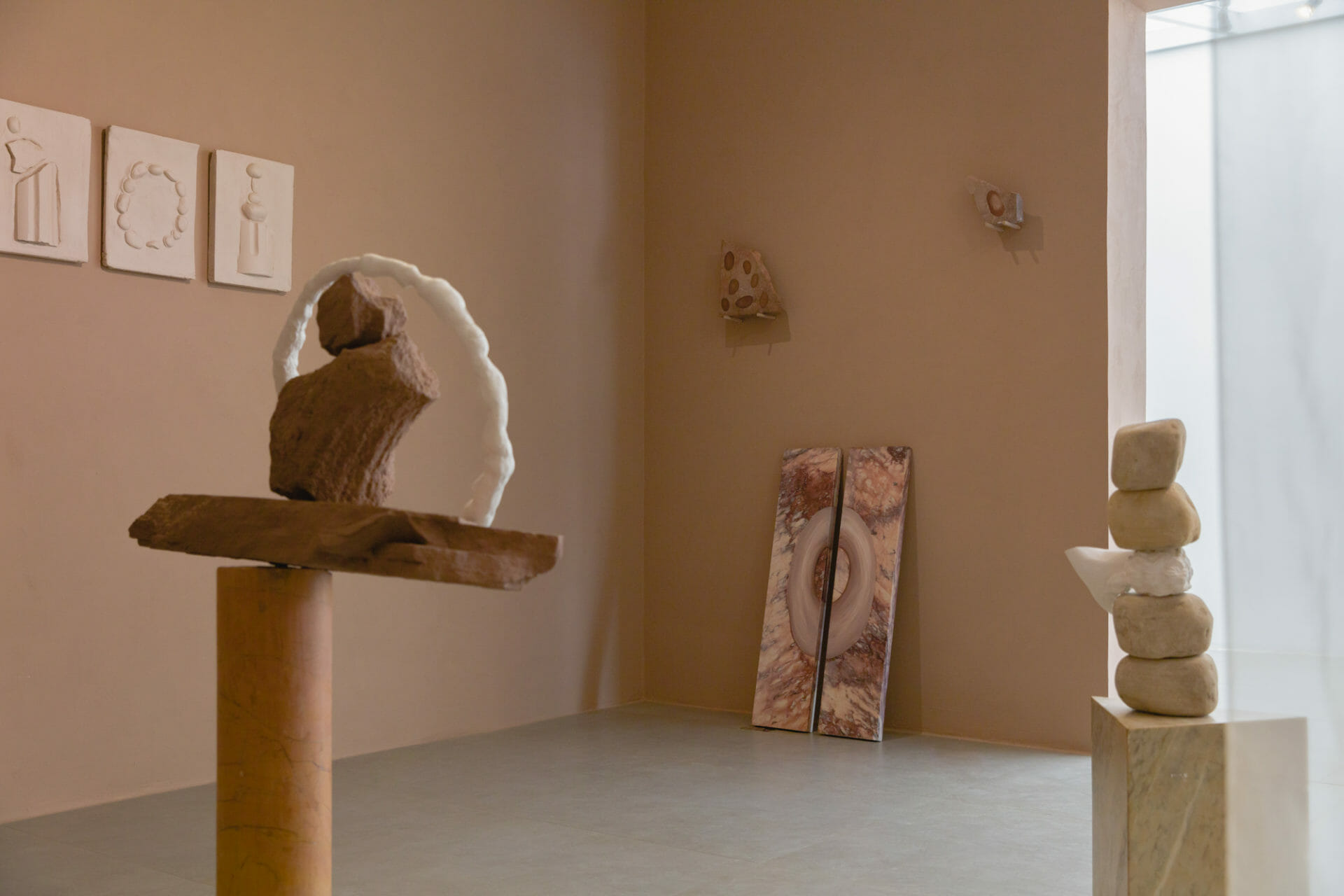
Gabriella Garcia
(Rio de Janeiro 1992)
Gabriella is a self-taught artist, whose practice ranges between sculpture, painting and installation. With a process that initially took collage as its driving force, Gabriella’s work comprises not only the place where it is, but also what it derives from. Cropped figures take the space from works where fabric, oil, plaster, supports, minerals, among others, dialogue in the construction of pieces that have, in their compositions, relationships with the scenic, architecture and with history. The images in the artist’s constructions, whether bi- or three-dimensional, work as if in a continuous effort of fusion: an incessant search for assimilation of materials that, in their essence, bring presence and representation in their materiality. The works put to the test a vivid exercise in the confrontation between gesture and nature; manipulation and relationship, creating a game where what is understood as terrain is the unique possibility that the artistic gesture has to make brutality, lightness. Illusion, reality. Gabriella participated in group exhibitions in Brazil such as “A Imensa Preguiça” at Galeria Sancovisky in 2019, “Da Lama Ao Caos” at Galeria Lume in 2020, Participated in the Pivô Pesquisa residency in 2018 and international ones such as “You know you can buy it”, at B32 ArtSpace (Maastricht, Netherlands), in 2015, “Collagism: a survey of contemporary collage”, at the Strathroy Caradoc Museum (Ontario, Canada), in 2016 and “Like me as you do”, at the Scandinavian Collage Museum (Rennebu, Norway) and also presented her first international solo exhibition “#FFFFFF” in Berlin at Galeria Aesthetik 01, curated by Kristina Nagel. The artist lives and works in São Paulo.

A sombra do peso
, 2021| T09 | EP37 | 2021 | L |
In the Mira do Arte1: Gabriella Garcia.
Directed by: Gisele Kato
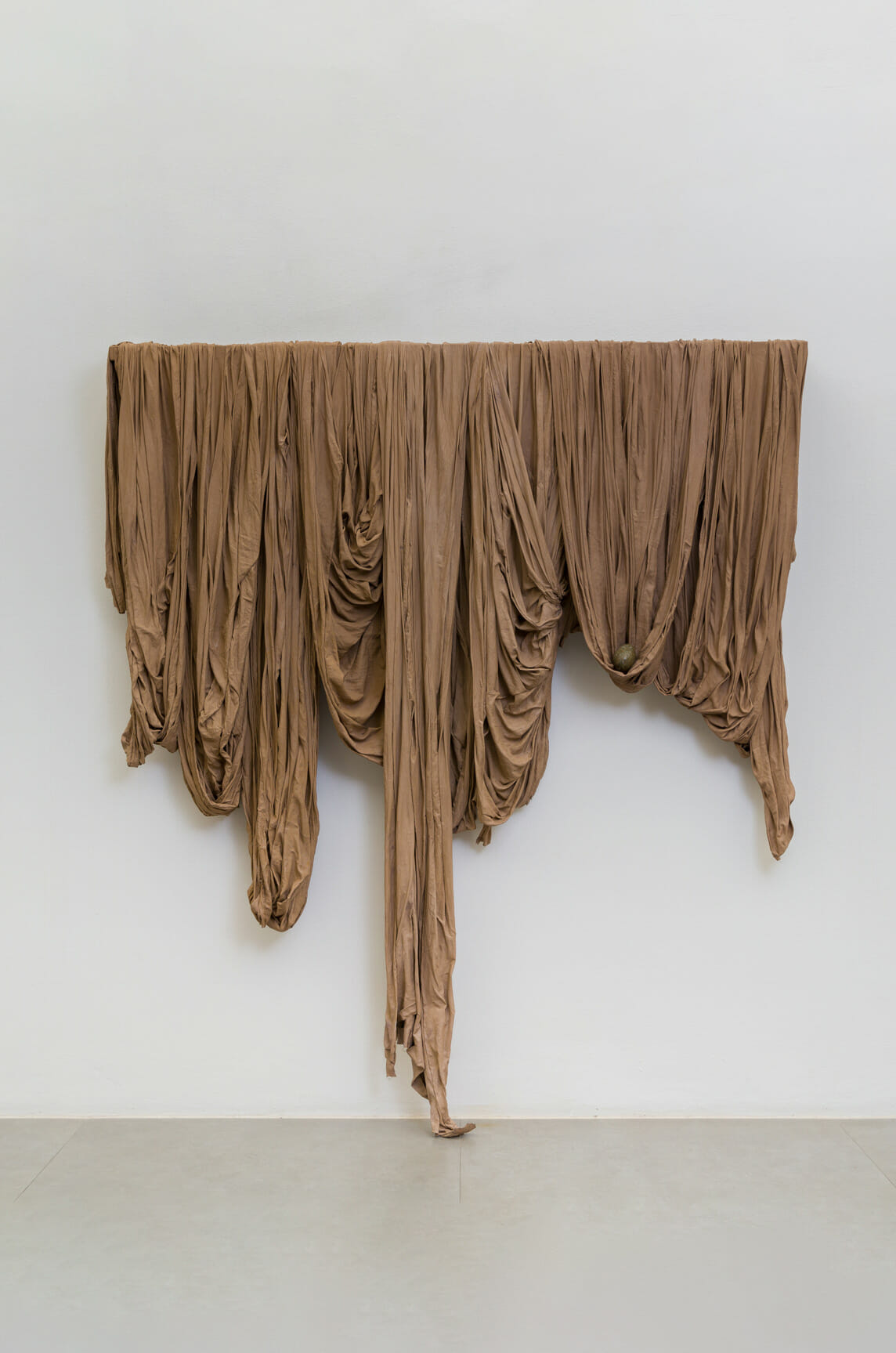
O sonho que ainda não sonhei
, 2021
Jurei mentiras
, 2021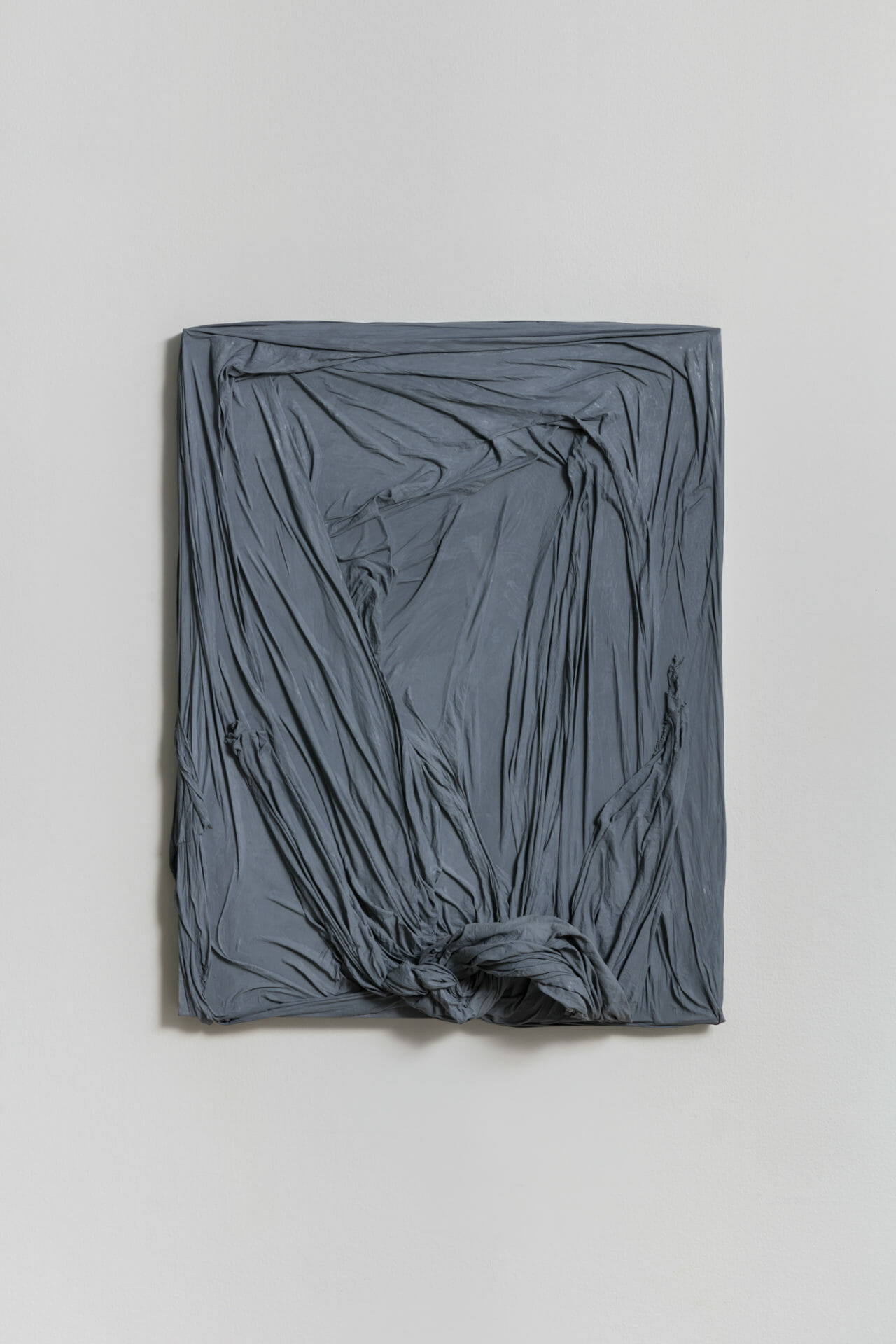
Qual o peso da sua consciência?
, 2021History, farce, repetition.
In Renaissance painting, it is known that what made a great work of art ideal was the absence of evident work traces, as if the image were simply an apparition that had not gone through the painter’s hand, that is, based on the idea that neither a brush nor paint was used in its execution. In some paintings, however, the layers of paint became more transparent over time, allowing some images underlying the canvas to become visible. In this way, by revealing the alterations in the forms and compositions of these pictorial representations, the painter’s changes of mind became visible, a phenomenon that in painting is called “pentimento.” Pentimento (pentimenti) is an Italian word linked to the idea of regret.
In the works presented in her solo exhibition, Gabriella Garcia elaborates a set of paintings and sculptures that deal, at first, with the idea of gestures and the very making of the art object. Nevertheless, the artist resorts to what is most academic and classic in art – whether in materiality or support – to justify an official history that has already been given. But those who think that Gabriella’s aesthetic choices corroborate the reiteration of a hegemonic thought are mistaken. When we observe the theatricality employed in her works, we begin to realize that, there, every gesture may be staged and that the layers can hide nuances that the eyes cannot see. As in the Renaissance ideal, the artist creates objects that keep “regrets” within themselves.
If we look at the history of dramaturgy, we notice that -like other realities in the universe of humanity- certain practices and certain characteristics apparently repeat themselves. If we pay more attention, though, we will find that they repeat themselves falsely, illustrating Karl Marx’s claim that history happens twice: “the first as a tragedy, and the second as a farce.” In Latin, the word “farce” implied the meaning of filling (farcire). The word has been used mainly in theater since Greece and gained special importance in the Middle Ages as a specific genre of spectacle.
If the mimetic sense of the spectacle had to do with the imitation of a certain action, the farce presupposed a filling -that is, additions- and had to do with the masks that were originally made under this name. An original situation or character was “filled up,” adding details and elements. To what end? With the purpose of criticism, such filling glass-magnified the quality or characteristic of the character or situation, intending to increase it, thus making it more visible and, consequently, more evident.
By bringing all these nuances of farces and regrets in her work, the artist tensions the narrative power that the images created in the world and how questioning them becomes extremely urgent and necessary so that history does not repeat itself as an even greater tragedy. If, in the spectacle, farce served as a kind of criticism and mockery for those who watched, acting, thus, with a social function of morality; in her exhibition, Gabriella Garcia places us as spectators in a story full of flaws and, therefore, of layers that hide her real intentions. Now it is enough to know how to act in front of them. Recognizing that the world as we know it is nothing more than a mere constructed illusion can be painful, but doesn’t this rupture also serve as a power to re-imagine the future?
– Carollina Lauriano
CISCO
Before being images, we were names: names responsible for assuming that we are progeny, remnants of stone stuck in the throat or the results of the dust that flows from the lining finish, lungs that have been tearing the earth for a thousand years and two minutes – from the Caucasus to Araripina in Pernambuco, claiming the possibility of naming.
Before we were images, we were names, and amalgamated things turned into words in a thousand languages. Powdered not only in matter but in the sense of what leaks from all mouths with their ideas and representations of species that do not know how to contain their own lexicon on their lips. We kiss the name’s forehead in search of pouring an image into the world through an enunciation. There is a place here where the image allows itself to fail, and it is because of its insufficiency in relation to the species’ will that something leaks out.
Before being images, we were names and also the only solid perspective of the immense desires to represent the species – at first – and the idea of a Greek thing that runs through a ceiling and breaks and diffuses light, emulating steps, volumes, control – in a second moment; guiltless particles, agents of a violence that did not belong to us.
Before we became images, we were already damned outgoing names, relegated to the walls of the lungs, to the rest of saints that would break on the ground, to the color that took over the streets of every city every four years, and to the way in which mountains forgot to cry while we made them a reason for heaven: and it is under the agglomerations of a thousand of us that the righteous lull their sleep through capitals.
Before being images, we were names, ore, geography, and choking. Before being images, we were names and violence to ourselves and to a thousand others; we were the failure of organs, the representations that form inside the cockroaches, and the reflection of everything, and here
we are, stained with time, bastions of the zeal of a species, and before being images, we are names.
– Guilherme Teixeira
Claiming uselessness as a strategic tool
In the calculations of Legacy Russell, American curator and writer, author of Glitch Feminism: A Manifesto (2020), the concept of glitch -that is, of “failure”- can mediate feminist poetics in virtualities as a metaphor, tool, and revolutionary attitude. In synchronous mode and starting at the same time as the beginning of the world-system to which we are now allocated, much is discussed and is organized under the formulation of value — a concept that -once crystallized- belongs to abstract concepts such as reality, being, existence, among others that do not contain a proper definition; therefore we can only try to illuminate the sense of value, not define it.
Thus, value is not absolute quality. Value is the relative quality of a material to be valued, which suggests the establishment of relationships between it and the human being; consequently, between this and the organizational and cognitive system of society. Gabriella Garcia, then, by using the premise that objectivity is always a minimum of subjectivity, invites us to shift our attention to the decay of any human classification system, building non-binary taxonomies that influence the body of works to be observed.
Thus, the harmonious pigments, drapes, and stacks hide a barricade: instead of ordering, they accentuate the chaotic and inextricable character of the yearning for what may come to be valued as organization and delight. Through the link of plaster and marble, studies on the balance of stones and objects and painting, profane materials and others with proper representative pride; as well as mimicry and the process of making motion static, Garcia aims to demonstrate how the negationist use of taxonomic models such as archetypes, catalogs, lists, and indexes, simultaneously with liquid properties such as astronomy, astrology, dreams, and memory, can be performed rhythmically and yet ironically.
A great number of traditional values, even the notion of reality, have their value called into question in the world today, and education for a sense of value and disvalue acquires a stiffened importance. In this way, the artist manifests through her own cosmogony, sometimes vulgar, a new diagram of values. Despite the relativistic field of art in which she is currently inserted, Gabriella Garcia is also eager to try to establish some basic principles that contribute to the construction of an imaginative and intersensory sphere — whose complexity is related to the determining factor in the experience of most human beings: the dream.
Being this one her analysis and assimilation tool, the effect of fluctuations in social and individual conditions, such as basic cultural ones, are not forgotten. In view of the subjectivity of Gabriella’s world being omnipresent in the world of her artistic production, the historiography of hegemonic art in general, which carry a millenary art tradition and may have value, do not necessarily have value in the same way for the artist: a man’s bust made of plaster and admittedly bought ready-made without shame, for example, is crushed by a stone in an exercise of stacking, balancing, and linear tonal propositions.
Finally, signs have values, always and exclusively, for human beings of a certain time or a certain cultural circle. They are enclosed in these values because the senses of visual communication fulfill certain functions. Signs cause pleasure, comfort, enjoyment, or even benefits and gains, by satisfying certain needs, as they are somehow useful to humans. However, there are no norms, nor formulas, nor rules that can deprogram the obsolescence of a body of art in which the power of imagination is not experienced. In view of this, in the dream created by Gabriella Garcia, uselessness is claimed as a strategic tool.
Of what?
– Ode
What do you know about me?
The research program proposed by Aby Warburg, a scholar of Renaissance art, to which many other researchers have dedicated themselves, defined images as symbols that form a collective memory that circulates through time, reactivating and modifying themselves by their insertion in specific historical moments. The past survives in the present as a temporality that is never effectively concluded. A widespread example is the re-reading of classical antiquity precepts in Renaissance art, more than a thousand years later.
In her first solo exhibition at Galeria Lume, the set of canvases and sculptures by Gabriella Garcia reveal themselves in almost theatrical constructions, governed with harmonic mastery. The allusions are clear. We could be in an unfinished scenario by Da Vinci, Michelangelo, or Caravaggio, in which the bodies disappeared. All that remains is the imaginary drawn by vesture, sculptures, and installations which, in the context of contemporary art, take on architectural forms and organic surfaces that evoke the idea of a society with a dystopian character. But what is this place where the vestures that run around the body of Pietá, or those that cover the bust of Monalisa, are protagonists over the bodies?
A possible interpretation arises in the sculpture in which a copy of the face of a Greek goddess (Athens?) is compressed by stones: “We are not that strong.” The deity of intelligence, wisdom, and arts is subdued. By chance?
Let’s go back to Ancient Greece. In Homer’s Iliad and Odyssey, spinning and weaving are purely female tasks. Not only does Penelope devote herself incessantly to the task, but countless female characters are portrayed performing this type of domestic craft. In a sexist society in which women were continually silenced, weaving was one of the few ways they had to communicate. Many myths address the power of pictorial communication of the robes and vestures produced by women. One of the most relevant tells the story of Philomela who, after being raped and having her tongue cut out by her brother-in-law, Tereus, embroiders what happened on a piece of cloth, which she presents to her sister, Procne, who understands the message and takes revenge on the husband.
The draped canvas covered in gray paint screams to the stories of the past: “How heavy is your conscience?”
In the exhibition “This dream can never happen,” Gabriella Garcia exposes her works to different interpretations. Not by chance, she invited four people from different backgrounds to describe what they saw. Thus, based on her own work, she proclaims: there is not a single narrative, a truth. Art history must be constantly re-signified.
Philosopher Gaston Bachelard writes: “You dream before you contemplate. Before being a spectacle, every landscape is a dreamlike experience.” Thus, the space of dreams has a veil as its background, a veil that illuminates itself in rare moments. Open to multiple reinterpretations, the exhibition allows us to release a critical spirit in the light of imagination and awaken to a reading of a multiform world.
– Paulo Kassab Jr.
Nós não somos assim tão fortes
, 2021Gabriella Garcia
Mitos, farsas e alegorias
, 2021Gabriella Garcia
Exibiu-se sua face verdadeira
, 2021Gabriella Garcia
Mitos, farsas e alegorias
, 2021Gabriella Garcia
A sombra do peso
, 2021Gabriella Garcia
O sonho que ainda não sonhei
, 2021Gabriella Garcia
Jurei mentiras
, 2021Gabriella Garcia
Qual o peso da sua consciência?
, 2021Gabriella Garcia


